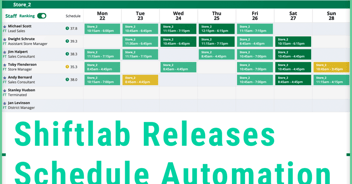
Shift Swapping: Effectively Managing Shift Swaps in Retail
Shift swapping plays a crucial role in maintaining flexibility for retail employees, but without clear systems in place, it can lead to staffing gaps and operational challenges. Retailers who establish a well-structured shift swap policy ensure consistent coverage and improve employee satisfaction. Effectively managing shift swaps keeps your team organized and operations smooth.
This guide offers practical strategies and solutions for retail managers to implement efficient shift swap procedures, ensuring a seamless balance between employee needs and business demands.
What is Shift Swapping?
Shift swapping is a practice that allows employees to trade their scheduled shifts with coworkers. For example, if Sarah is scheduled to work on Saturday but has a family event, she might swap her shift with John, who was originally scheduled for Sunday.
Swapping shifts is commonplace in most retail organizations, and often necessary in order to deal with unexpected situations and avoid being short-staffed. Having a defined policy in place for shift swapping should be a key part of your retail scheduling process.
Challenges of Shift Swapping
While swapping shifts can be very beneficial to your retail team, it's not without its challenges. Some of the most commonly seen shift swap challenges include:
Communication issues. Ensuring that everyone (the employees involved and management) is aware of the swap ahead of time is critical for avoiding misunderstandings or other potentially bigger problems.
Skill mismatches. If two employees are going to swap shifts, you should make sure the team member taking the shift has the necessary skills to cover it. Maybe it’s a closing shift, but they’ve never closed before — you should catch this ahead of time to find a better candidate, or train them before they actually take the shift in question.
Overtime concerns. For many companies, avoiding potential overtime due to shift swaps is a high priority to ensure they stay on budget.
Fairness. This will be unique to each team, but it’s important to prevent favoritism or unequal swap opportunities whenever possible.
Benefits of Shift Swapping
Despite these challenges, shift swapping offers significant benefits to both your employees’ well-being and satisfaction and your store performance. It’s worth enabling your team to swap shifts — as long as you set rules in place (more on that below).
Here are a few of the key benefits of shift swapping:
Increased employee satisfaction. Swapping shifts gives staff more control over their work-life balance and allows them to attend to unexpected situations that arise in their personal lives. A well-rested, well-balanced employee is a happy employee who is more likely to stick with your company longer. It can also help improve your employees’ time management and productivity.
Improved coverage. Shift swapping obviously helps ensure shifts are actually covered and not left empty, even when unexpected events occur. This reduces the negative impact on the rest of your team and store performance.
Reduced absenteeism. Similar to the point above, employees are less likely to call out if they can swap shifts instead.
Enhanced teamwork. Shift swapping encourages employees to communicate and help each other out, helping to boost your team’s morale and overall relationships with one another.
How to Manage Shift Swaps: Tools & Best Practices
To make shift swaps work for your retail organization, consider these best practices:
- Create a clear policy. Establish written rules about how shift swaps should be requested, approved, and communicated. See the checklist of what your policy should include in the section below.
- Set boundaries. Define how far in advance swaps must be requested and any limitations on frequency.
- Ensure proper coverage. Make sure all necessary roles and skills are covered after a swap.
- Use technology. Implement a digital solution to streamline the process and avoid confusion.
Building a Shift Swapping Policy
A well-defined shift swapping policy benefits both managers and employees. Your managers will have peace of mind that any shift swaps are run through a defined approval process, and your employees will be empowered to easily swap shifts if they need to.
Here’s a checklist of what your shift swapping policy should include:
- The specific process for requesting and approving swaps
- Deadlines for swap requests
- Any restrictions on who can swap with whom
- How swaps will be communicated to all relevant parties
- Consequences for not showing up for a swapped shift
Once you build your shift swap policy, communicate it to everyone on your team and publish it in a place where they can easily find it when needed.
Leveraging Technology for Shift Swapping
Modern workforce management platforms can greatly simplify the shift swapping process. Shiftlab, a strategic employee scheduling and workforce management platform, offers tools specifically designed for retail organizations.
Shiftlab's Shift Swap Features
Shiftlab’s Shiftswap feature offers your team the flexibility to swap shifts while ensuring your labor strategies are met.
This functionality allows your frontline retail staff to trade or pick up shifts from co-workers, all while following pre-set rules. Give your employees more control and flexibility over their work schedule and save managers time with schedule change requests.
- Employees can swap or drop their shifts with the ability to cancel any pending before it is claimed
- Shiftlab automatically adjusts the schedule when a shift swap is accepted so no manual work is required to adjust the schedule
- Mobile view for employees shows their current pending requests on the timeclock screen, day and week views
- Mobile view for managers displays their team’s current pending shift swap requests with the ability to cancel any pending request
Shiftlab's Open Shifts Tool
When you are down a staff member in your store and need to fill the shift quickly, Shiftlab’s Open Shifts feature is there to save the day.
Simply pop an open shift into your location, share it with employees from other stores, and have someone grab it to help fulfill your staffing needs.
- Enables creation of open shifts when you're short-staffed
- Allows sharing of open shifts with employees from other stores
- Lets managers assign open shifts to available employees
By using a platform like Shiftlab, you can give your employees the flexibility they desire while maintaining control over your labor costs and scheduling needs.
Implementing an effective shift swapping system in your retail organization can lead to happier employees, better coverage, and smoother operations. By establishing clear policies and leveraging the right technology, you can turn the potential challenges of shift swapping into opportunities for improved workforce management.
%201.png?width=564&height=119&name=Shiftlab_Logo%20(Black)%201.png)



